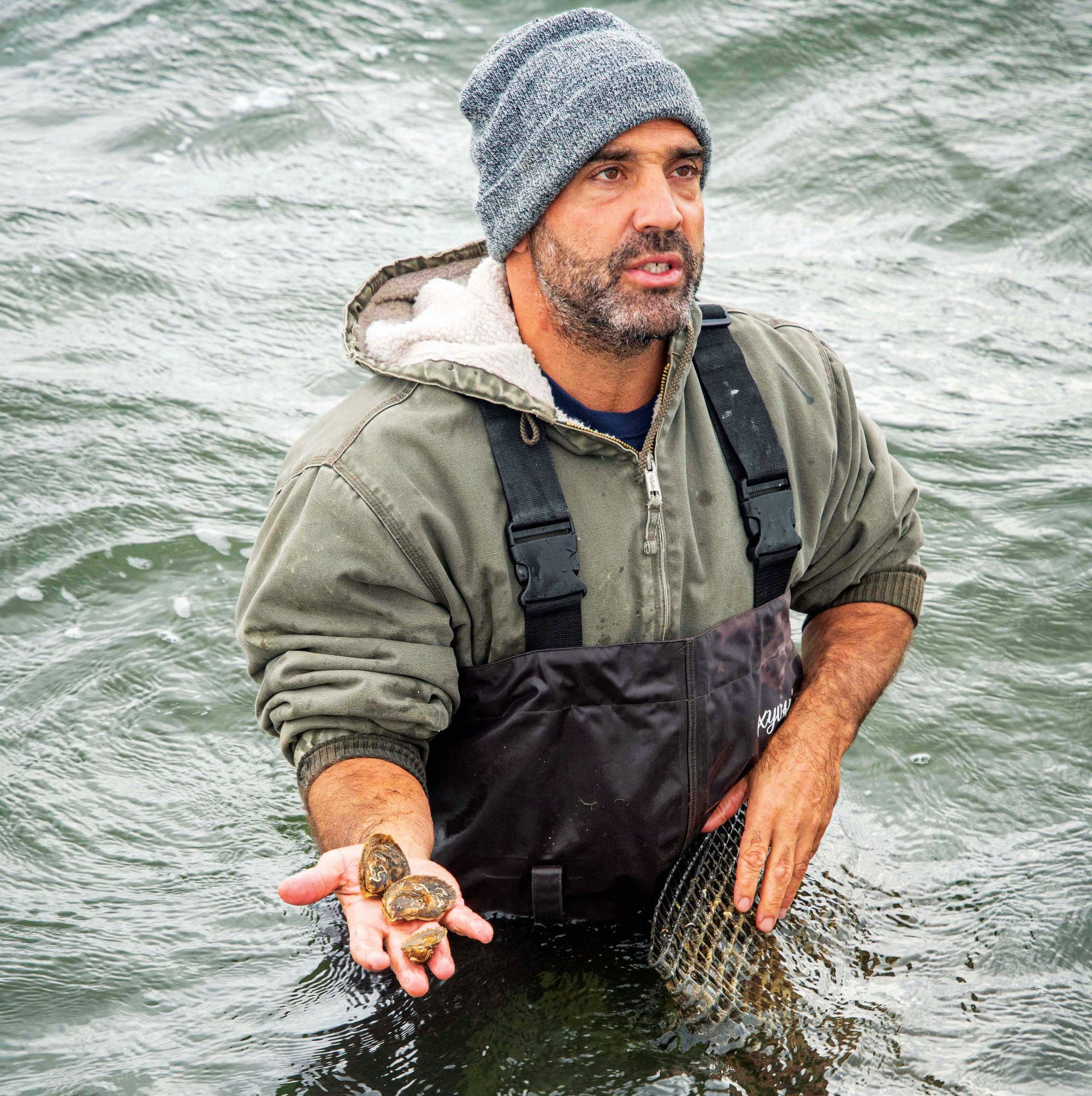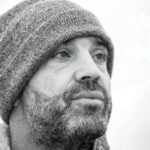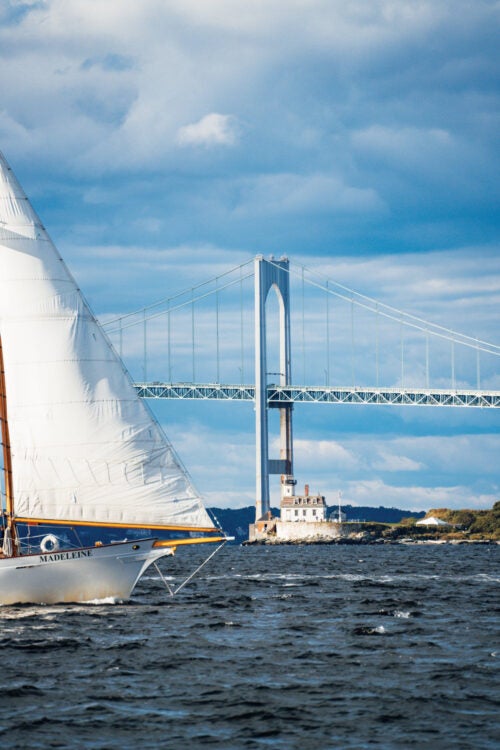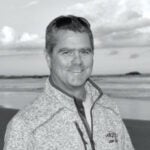
Perry Raso ’02, M.S. ’06, harvests oysters from Potter Pond at Matunuck Oyster Farm. Photo: Nora Lewis
The ocean-based blue economy is the lifeblood of Rhode Island—and powered by URI alumni.
By Michael Blanding
A light rain spits from the sky and the smell of salt fills the air as Perry Raso ’02, M.S. ’06, founder and owner of Matunuck Oyster Farm, stands waist-deep in Potter Pond, in South Kingstown, R.I. “This is farming,” he says, “it’s just underwater farming.” Dozens of buoys fill the cove where he stands, lines strung between them marking off 60 rows. Each line carries a half-dozen or so polyurethane plastic bags, which are, together, filled with thousands of oysters. “They are just like rows of corn,” Raso says, grinning.
Raso wears waders over a light green barn jacket. His salt-and-pepper beard and gray beanie protect his head from the rain. He pulls out one of the stiff bags, algae hanging off it like Spanish moss. Removing the clamp at the end, he reaches in and pulls out three fresh oysters, which he lays on his palm. “That teardrop shape is what we go for,” he says approvingly, pointing out the slightly pointed end on one side, and the deep cup filled with oyster meat.
At any given time, some 10 million to 15 million oysters are growing in Raso’s farm. Each year, the operation harvests a million of them. Many will be eaten just a few hundred yards away at Matunuck Oyster Bar, which Raso purchased in 2009 as a run-down seafood shack and transformed into a fine-dining destination that brings locals and tourists by the droves. The transformation of Potter Pond to a working farm and restaurant mirrors the rise of aquaculture in Rhode Island, which has grown into a booming industry with $7.5 million in annual sales from oysters, scallops, kelp, and other ocean produce.
The direct impact of the ocean-based economy in Rhode Island is $5 billion.
Aquaculture is only one of Rhode Island’s blue—or ocean-based—economy success stories. With hundreds of miles of coastline and the sprawling expanse of Narragansett Bay, Rhode Island is inextricably tied to its seaside location. From the quahogs and kelp that have been harvested by Rhode Island’s Indigenous peoples for millennia to the offshore wind turbines that symbolize renewable energy, the ocean has long been integral to sustaining Rhode Islanders’ lives and livelihoods. And its importance is reflected in the disproportionate impact of businesses reliant on the ocean. A recent report by URI’s Graduate School of Oceanography (GSO), Coastal Resources Center (CRC), and Rhode Island Sea Grant calculated that 6%–9% of Rhode Islanders work within the blue economy, more than twice the percentage of states such as Massachusetts, Texas, or California.
According to the report, the direct impact of the ocean-based economy in Rhode Island is $5 billion, or 10 percent of the state’s gross regional product. The impact spans industry sectors including defense, marine trades, ports and shipping, tourism and recreation, fisheries, aquaculture, and offshore wind. As the state’s preeminent public educational institution, URI plays an outsized role in spurring that economy, from providing research that bolsters industry know-how, to helping launch ocean-based startups, to serving as an honest broker between industries when ocean uses inevitably come into conflict.
Recently, URI partnered with the state and the private sector on a plan to increase the number of workers in the blue economy from 36,500 to more than 85,000, and to increase the economic output by $15 billion to $25 billion over the next 10 years.
The coalition, dubbed the Blue Economy Technology Cluster (BETC, or “Betsy”), was a finalist in 2021 for a $70 million federal Build Back Better Regional Challenge grant. Though it ultimately did not receive the grant, BETC is proceeding with the projects it planned—with URI’s help—seeking alternate funding for a SmartBay monitoring system, a Blue Technology Innovation Center on URI’s Narragansett Bay Campus, and other projects to transform the state’s fisheries, ports, and offshore wind capabilities.
But perhaps URI’s greatest contribution is the people who fuel these industries. URI graduates jump into the blue economy with both feet, leading public, private, and nonprofit organizations, working hard, and innovating. “The people here are all heart and soul,” says GSO Dean Paula Bontempi, Ph.D. ’01. “They connect ocean exploration with ocean economics and everything in between.”
A lobsterman at work in Rhode Island waters. Photo: Aisha McAdams
Food from the Sea
Raso is a good example. He grew up digging for littleneck clams in Point Judith Pond, trapping eels and diving for steamers as he got older. He went to The University of Northern Colorado to study biology. “I realized I loved the ocean,” he says, “when I was away from it for the first time.” He transferred to URI and stayed for his master’s degree in aquaculture.
“Shellfish aquaculture is one of the most sustainable types of agriculture,” Raso says. Requiring no inputs from outside, oysters filter phytoplankton from the water, cleaning it and increasing the oxygen that fish and other species need to survive. While the state once saw its oyster industry dwindle, aquaculture is now booming, with more than 80 operations statewide.
Starting with a 1-acre lease in 2002, Raso now operates some 7 acres on Potter Pond. Five years ago, he applied for a permit to farm an additional 3 acres of the pond. Despite an initial recommendation for approval from the state’s Coastal Resources Management Council (CRMC), residents protested the expansion over fears of its impact on recreation, and the CRMC’s four-member aquaculture subcommittee denied the application. Raso contends that the increase he sought would bring the total area of aquaculture in the pond to only 3 percent, less than the 5 percent allowed by the state. The fight, however, demonstrates the sometimes-competing interests within the blue economy.
One area of Raso’s operation where there is no conflict is his oyster hatchery, which provides the tiny seed oysters necessary for Matunuck and other farms in the state. Responding to difficulties sourcing seed in past years, he now sells some 5 million seed oysters annually. BETC plans to partner with Raso, URI, and other farmers to dramatically increase that output with a smart shellfish hatchery that could supply up to 150 million seed oysters at a value of $1.2 million to the more than 600 farms along the Eastern Seaboard.
Aquaculture isn’t the only seafood industry booming in Rhode Island. Shellfishing—especially for quahogs—is undergoing a massive resurgence. “Starting in 2010, things were really going down, people were struggling to make a living,” says Mike McGiveney ’80, president of the Rhode Island Shellfisherman’s Association. That has changed in the past few years. “We’ve harvested more clams this year than we have in the past 20.”
Shellfishing—especially for quahogs—is undergoing a massive resurgence.
McGiveney has one explanation for that: water quality improvement. The state has invested $1.6 billion in new tunnels to divert, store, and treat wastewater overflow before returning it to the bay. As a result, areas of the Providence River that were closed for more than 75 years are newly reopened to quahoggers. “It’s brought a lot of people back,” says McGiveney, who graduated from URI with a political science degree. “I’ve seen faces again I haven’t seen in 20 or 30 years.”
Commercial fishing for finfish has also been on the increase. “People have an impression that commercial fishing is a dying industry,” says Jason McNamee ’96, Ph.D. ’18, deputy director for the bureau of natural resources for the state Department of Environmental Management (DEM), “but it’s exactly the opposite—our landings have been picking up year after year.” In total, fisheries bring $151.5 million to the state economy, employing nearly 3,000 people. Interestingly, the recent uptick is in part due to gradually warming waters along the East Coast, which is shifting species of fish northward—a result of climate change.
“Our fleet transitioned away from a classic New England fishery of cod, pollack, and haddock into more mid-Atlantic species, like black sea bass, summer flounder, and squid,” McNamee says. He studied zoology at URI and biological oceanography at the University of Connecticut before joining the marine fisheries program at DEM, where he participated in managing the state’s fisheries. He came back to URI for his Ph.D. to help him in that role. “I wanted to get better at technical stock assessment and population dynamics,” he says. “I wanted to bolster my understanding of the math behind it.”
In the past, McNamee says, fisheries have been managed with a static sense of how many species will be in a given area and the premise that populations have stationary productivity—not a realistic approach given the dynamic nature of climate change. He has been part of a group effort to develop more complex population models to manage fish quotas that will maintain sustainable populations.
Putting the Green in Blue
“Be careful, the floor could be a little wet,” says GSO Dean Bontempi, leading the way through the Fish Laboratory at URI’s Narragansett Bay Campus. The room is full of tanks, some open and bubbling, others covered, with some critters—lobsters, sea stars, clams—visible beneath the rippling water. “Scientists here are conducting basic research, but also thinking about the applied piece, and feeding it into management and policy to make it economically relevant,” Bontempi says.
A doctoral graduate from GSO’s oceanography program, Bontempi spent 20 years at NASA as deputy director of its Earth Science Division. She came back to URI to head GSO in 2020 and is now overseeing an exciting overhaul of the campus. “That parking lot will be a new ocean robotics laboratory,” she says, pointing as she walks across the Bay Campus in a light rain. “It’s going to put all our oceanography and ocean engineering faculty under one roof. The lab will house a giant test tank, fabrication spaces, and a public viewing platform.”
In November 2022, Rhode Island voters approved a $100 million bond to improve and upgrade the Bay Campus. In addition to the 27,000-square-foot robotics laboratory, the University has broken ground on a new pier to accommodate a new advanced research vessel, R/V Narragansett Dawn. It will also build a new engineering complex and ocean laboratories.
Aside from the bond-funded improvements, the proposed Blue Technology Innovation Center at the Bay Campus will serve as an incubator for ocean-focused startups and an operations center for the proposed SmartBay—a network of sensors distributed throughout Narragansett Bay to provide data for research and commercial ventures. In addition, the Bay Campus master plan includes renovations to the CRC, which supports the state on blue economy initiatives.
The CRC has been particularly active in offshore wind. Rhode Island is home to the first operating commercial wind farm in the United States: the 30-megawatt, five-turbine Block Island Wind Farm, which began operations in 2016. A more ambitious project is now underway in Narragansett Bay: Revolution Wind, a 704-megawatt project with up to 100 turbines, currently led by energy companies Eversource and Ørsted. When complete, the project will supply power to Connecticut and Rhode Island, helping Rhode Island achieve its first-in-the-nation goal of 100 percent renewable energy by 2030.
CRC has been facilitating conversations between the companies, state officials, and commercial fishers concerned about the wind farm’s impact on their industry. “Our role is breaking down silos by creating forums for discussion,” says Claire Hodson, M.E.S.M. ’18, a CRC research associate who graduated URI with a master’s in environmental science and management and then worked on a charter fishing boat and for an environmental nonprofit, giving her a uniquely broad perspective. “We’re brokers of good science and can be a bridge of knowledge and information, making resources available to both sides,” she says. Commercial fishers have expressed concern that noise from the turbines will impact fish populations, as well as fears about snagging and losing gear on the turbines.
Wind turbines, Block Island Wind Farm, Photo: Kyle Sidlik
Hodson has been working with fishers who feel their input wasn’t included in initial conversations about the siting of the wind farm on Cox Ledge, a historic fishing ground. “They feel like they were not valued, and that has led to a lack of willingness to engage and participate, which furthers conflict and leads to a more inequitable process,” Hodson says. For better or worse, she says, the state is going full steam ahead with the project, so CRC is working as a neutral party to improve the process. “We’ve spent many years trying to understand the conflict, and now we are moving toward solutions,” Hodson says. Adopting new gear for automatic squid-jigging equipment to mitigate safety concerns and employing fishers in activities that could return economic benefits to the industry, such as wind-farm surveying, are among solutions being discussed.
The investment in renewable energy is only the beginning when it comes to sustainability in the bay, says Sandra Whitehouse, Ph.D. ’94, a longtime advocate for ocean health and sustainable coastal communities. “In my definition, the blue economy only pertains to ocean uses that are sustainable,” she says. “That means minimizing impacts and having a big overlay on the climate change implications of anything you are doing.”
Whitehouse grew up in Rhode Island and spent her summers on the beach. “I was the kid with a bucket picking up crabs and shells and looking at them under a little microscope,” says Whitehouse. After earning an undergraduate degree in biology at Yale, she earned her Ph.D. in marine biology at URI’s GSO.
While she was working on her dissertation on benthic ecology, studying creatures that live in the mud, she was contacted by a representative of the governor for help examining the impact of an oil spill in 1989. “It was an ‘aha!’ moment for me that there were not a lot of scientists involved in policymaking,” she says. After earning her degree, she set out to change that, joining the CRMC board and later serving as the chair. Since then, she has consulted for ocean-based nonprofits and companies.
Among her accomplishments is helping create the first comprehensive national ocean policy framework for the Obama administration. “It was the first time an ocean policy for the United States had the force of law,” she says, even though it was codified as an executive order rather than passed as legislation. “It also provided direction to federal agencies that addressing climate needed to be an integral part of ocean planning.” The executive order called on nine U.S. regions around large marine ecosystems to develop ocean plans that balance sustainable development and ocean health. State governments’ interests in constructing wind farms off every coastline was the catalyst for the first two plans, which were completed for the Northeast and Mid-Atlantic regions. “If you talk to wind farm developers, they will probably say that having those regional plans has been really helpful to them in their work.”

△ Perry Raso ’02, M.S. ’06, founder and owner, Matunuck Oyster Farm

△ Paula Bontempi, Ph.D. ’01, dean, URI Graduate School of Oceanography

△ Mike McGiveney ’80, president, R.I. Shellfisherman’s Association

△ Jason McNamee ’96, Ph.D. ’18, deputy director, Bureau of Natural Resources, RI DEM

△ Claire Hodson, M.E.S.M. ’18, research associate, URI Coastal Resources Center
A massive new onshore infrastructure will support the construction and maintenance of the new wind farm off the coast of Rhode Island. Much of that will be based at Quonset Business Park in North Kingstown, R.I., where the main electrical cable will connect to an energy substation. Meanwhile, Quonset’s Port of Davisville will also house a fleet of crew transfer vessels to ferry workers and supplies to the construction site—approximately 19 miles offshore, says Steven J. King ’88, managing director of Quonset Development Corp., the quasi-government agency that manages the business park and the port, located on the site of two former naval bases. “Wind farms obviously need human hands to build them, and the humans need to be transported, fed, and watered, and have tools and equipment brought to them,” King says. Quonset is also exploring ways to create a multimodal hub to transport workers to the wind farm via helicopter.
Ports and shipping bring in $757 million to Rhode Island, and support 2,000 jobs. Quonset is a major destination for shipping; it’s a top-10 location in North America for automobile imports and the largest exporter of frozen squid and other seafood on the East Coast. Quonset business park, meanwhile, houses 228 companies employing 13,000 people, including General Dynamics Electric Boat, a leading manufacturer of submarines for the U.S. Navy. The biggest challenge, says King, is fitting in all the sea-facing industries that want frontage. “It’s hard to come by unused space along the waterfront,” he says. The port is currently undergoing a $243 million redesign that will build out the piers to provide more space to support offshore wind and other maritime uses. “Those investments will be key for both existing businesses and new businesses that come with the wind farm development.”
A rigging team steps a mast at Safe Harbor Marinas. Photo: Courtesy Safe Harbor Marinas
Boats Under and On the Bay
The submarine building at Electric Boat is just the beginning of Rhode Island’s substantial ties to the defense industry, which date back to the U.S. Naval Torpedo Station, built in Newport just after the Civil War. The facility has gone through various iterations over the decades, and is now known as the Naval Undersea Warfare Center (NUWC) Division Newport. NUWC headquarters chief technology officer Vittorio “Vic” Ricci, M.S. ’96, Ph.D. ’01, has worked at NUWC since 1984, when he arrived from Syracuse with an aerospace engineering degree to work on the Navy’s Tomahawk Cruise Missile program. He has since earned two advanced degrees from URI and now oversees an array of technologies, all focused on making America’s submarine fleet stronger and more effective.
In addition to military boatbuilding, civilian boatbuilding is thriving in Rhode Island, too.
“It may take a long time to move an application into industry and into the sailor’s hands,” Ricci says. “There are things we’ve worked on at NUWC that have literally taken 30 years.” His time at URI, he says, helped him realize the depth of research needed to roll out a new technology. “It’s not just maturing the technology, but all the systems and support around that technology.” In that regard, NUWC is often supported by URI ocean engineers, who devote time and expertise to developing breakthrough technologies. In 2019, that relationship was formalized in the Naval Institute for Undersea Vehicle Technology (NIUVT), a partnership between URI, UConn, Electric Boat, and NUWC Newport to jointly develop new technologies; it has since expanded to include 16 government and industry partners, with government grants of nearly $40 million, so far.

“Working underwater is at least as challenging—probably more challenging—than working in outer space,” Ricci says, citing energy and communication between vehicles as just two difficulties of the undersea environment. “The first hurdle is getting to a common language and understanding what problems need to be solved. NIUVT has taken that to the next level by harnessing the resources of the universities to understand the needs of users at NUWC and Electric Boat.” The Navy’s presence has further spurred an ecosystem of startups and defense contractors in Rhode Island and throughout the region that contributes some $3.6 billion and employs more than 16,000 people—by far the largest slice of the blue economy.
In addition to military boatbuilding, civilian boatbuilding is thriving in Rhode Island, too. Marine trades add $1.45 billion to the economy and employ more than 13,000 people. The industry received a boost during the COVID-19 pandemic, when many businesses suffered, says Pete Colby ’91, director of project development for Safe Harbor Marinas. “A lot of people bought boats during the pandemic,” he says. “Driving over the bridges, you saw boats everywhere.” While congregating inside wasn’t safe, being out on the water in a boat was one of the few places people could feel at ease, says Colby, who frequently took his own family out on their 30-foot sailboat.

△ Sandra Whitehouse, Ph.D. ’94, president, Ocean Wonks LLC and founding member of Ocean Collectiv

△ Steven King ’88, managing director, Quonset Development Corp.

△ Vittorio “Vic” Ricci, M.S. ’96, Ph.D. ’01, chief technology officer, Naval Undersea Warfare Center Division Newport

△ Peter Colby ’91, director of project development, Safe Harbor Marinas

△ Martha Sheridan ’83, President and CEO, Meet Boston
Colby’s father bought a J/29 racing boat for the family when he was 14—but no one in the family knew how to sail it. Eventually, Colby took up the challenge, getting better and better during his teen years. “I got hooked on being out on the water and the freedom of it,” he says. As a first-year student at URI, he wasn’t sure what he wanted to study and took a year off working for a sailmaker. When he returned to URI the next year, he joined the sailing team, racing keelboats. “We went to France for a world championship senior year—and won,” he says.
The ocean and beaches are key assets for Rhode Island tourism, a $4.3 billion industry employing more than 80,000 people.
After earning an economics degree, he went to work full time for the sailmaking company, which became North Sails, eventually running manufacturing for all of North America. Now he runs project development for Safe Harbor Marinas, which has 11 marinas around Narragansett Bay, performing custom building jobs for boat owners. “We do everything from building new boats to sanding bottoms to putting in new rigs,” he says. “We’ll take out an entire interior and put a new one in.” He’s expecting the sailing boom to continue post-COVID, as many people discovered the joys of being on the water. “People have them now—and you know, a boat isn’t cheap,” he says. “They are going to use them.”
The same appeal that draws locals out onto the water also draws tourists. “Since the pandemic, outdoor activities are key when people look for destinations,” says Martha Sheridan ’83, who has long been involved in Rhode Island tourism marketing. “I think that bodes well for Rhode Island.” Sheridan, who held top positions at the Providence Warwick Convention and Visitors Bureau and South County Tourism Council, is now president and CEO of Meet Boston, the city’s visitors bureau.
Sheridan, originally from South County, says, “I grew up with my family on the water. I’ve always been obsessed with the ocean.” She studied psychology and English at URI, thinking she would become a social worker. Meanwhile, she was working as a tour guide at the Newport mansions and loved interacting with tourists and showing off Rhode Island’s history and culture. “That gave me the bug, and I’ve been in tourism ever since,” she says.
The ocean and beaches are key assets for Rhode Island tourism, a $4.3 billion industry employing more than 80,000 people. “The ocean is a huge part of how we have always sold the state. People may go to Disney or Vegas, but when it comes to downtime and relaxation, being on the water is never going to get old.” More than ready access to the ocean, she says, it’s Rhode Island’s particular approach to waterfront development that makes it so appealing. “What’s unique about Rhode Island is the authenticity,” Sheridan says. “It doesn’t have theme parks or the huge resorts of Florida and Hawaii, or the overdevelopment of North Carolina.” Even in populous areas such as Newport, thoughtful development policies have prevented overbuilding and kept the waterfront at a people-friendly scale.
Of course, URI feeds the tourism industry as well, through out-of-towners attending URI sports events, prospective students and families visiting the area, or the influx of visitors during Alumni & Family Weekend, reunions, and Commencement. What really makes the Ocean State such a draw for tourists and locals alike, perhaps, is the way all aspects of the blue economy combine to create an experience greater than the sum of its parts. Sheridan singles out Matunuck Oyster Farm, both for its restaurant and for its tours, which show off the aquaculture industry. “It’s a great example of how tourism and the blue economy intersect,” Sheridan says.
Similarly, when the Block Island Wind Farm first went up, the tourism industry worried that the turbines might spoil the view; instead, charter boats began offering wind farm tours and recreational fishers began seeking them out as spots where fish congregate. Such examples highlight just how dynamic Rhode Island’s blue economy is and how all the parts can work to complement each other. Clean water efforts jump-start the shellfishing industry. Fishing boats survey offshore wind farms. The defense industry spurs startups to pursue undersea technology. And, of course, through it all, URI alumni—as well as faculty, staff, and students—are just beneath the surface, making it hum.
Photos: Nora Lewis; Aisha McAdams; Courtesy Safe Harbor Marinas; Corey Favino; Alex DeCiccio; Monica Allard-Cox; Kyle Sidlik; Courtesy subjects
URI grads are working in new segments of the blue economy, too. Current Lab, the brainchild of Kevin Rosa ’13, Ph.D. ’20, provides detailed ocean forecasts, changing the game for ocean- going endeavors from competitive sailing to global shipping.
If you want to predict the weather, it’s easy to pull up a forecast on your phone for any given location. Until recently, however, sailors couldn’t do that for ocean conditions—having to rely instead on low-resolution models from government agencies such as the National Oceanic and Atmospheric Administration and the European Union. Kevin Rosa ’13, Ph.D. ’20, bridged that gap with his startup, Current Lab, which provides detailed regional models of currents and other ocean conditions. “It’s a weather forecast,” says Rosa, “but we’re doing it for the ocean, specializing in super-fine scale, hyperlocal forecasting.”
Rosa has worked on boats since high school and manned a schooner in college while earning a physics degree at URI. As a doctoral student at the Graduate School of Oceanography, he used supercomputers to calculate complicated fluid dynamics—using publicly available data such as ocean depth, wind, and shoreline topography to determine the underwater flow of currents. Originally, he planned to use these techniques to track pollution. But when a member of the America’s Cup sailing team approached him after a presentation, asking if he could help them gain an edge in their next race, Rosa began consulting for sailors. His clients included the U.S. Olympic team, and he helped them shave critical minutes off their times.
Sailors continue to be the main subscribers to Current Lab’s web app, which offers an interactive map that can zoom in on specific locations. “Sailors are hungry for this information,” says Rosa, whose forecasts are 50 times more detailed than those offered by government agencies.
He’s grown the company through the Mass Challenge and Blue Swell incubators, relying on subscriptions for revenue. He aims to draw in a diverse range of clients, including offshore wind and autonomous underwater vehicles, with the detailed forecasts his company produces.
He’s even working with a data science group at Brown University on a model using satellite data that could help reroute global shipping vessels based on changes in currents. “This could save on tons of fuel costs and carbon emissions for the shipping industry,” Rosa says. “It’s not only super-exciting stuff, but it could also be super important from a climate perspective.”
—Michael Blanding

loved “keeping current with kevin rosa.
In reading this, I learned a lot about the blue economy. Great comprehensive article.
Donna Longo DiMichele, B.A. 1974